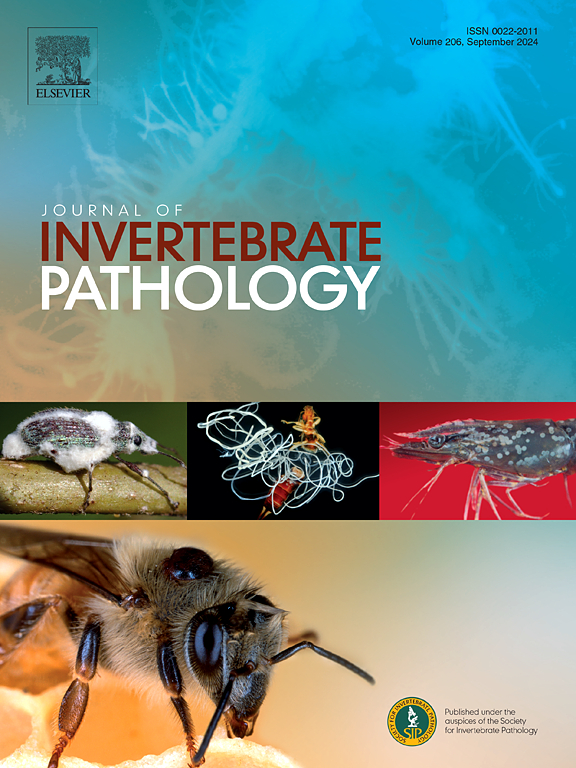一种新微孢子虫的形态和分子特征研究(甲壳纲:田鼠科)
IF 3.6
3区 生物学
Q1 ZOOLOGY
引用次数: 0
摘要
本文报道了从江苏省连云港市富营养化水体中采集到的一种微孢子虫。由于脂肪组织中大量孢子的积累,感染的支海动物表现出不透明。最早观察到的阶段是与宿主细胞质直接接触的无核小块。多核孢子胞浆被切浆形成单核孢子母细胞。成熟孢子卵球形,单核细胞,长4.80±0.37(4.09-5.23)µm,宽2.64±0.15(2.34-3.01)µm。极质体分为两部分,前片和后小管紧密排列。等丝极性灯丝绕成9-10圈,排列成2-3行。外孢子被管状突起覆盖,由四层组成。基于SSU rDNA序列的系统发育分析表明,本种与来自淡水寡毛纲(oligochaetes)的N. dubium和来自淡水水蚤(daphnia)的N. aurantiae两种Neoflabelliforma种以及来自土壤的未识别的高支持值微孢子虫聚集在一起,形成了微孢子虫的孤支。基于形态特征、超微结构特征和SSU rdna推断的系统发育,将新种命名为Neoflabelliforma leuchtenbergianum n. sp。本文章由计算机程序翻译,如有差异,请以英文原文为准。

Morphological and molecular characterization of a new microsporidium, Neoflabelliforma leuchtenbergianum n. sp. from the adipose tissue of Diaphanosoma leuchtenbergianum (Crustacea: Sididae) in China
This study describes a new microsporidian species from the adipose tissue of Diaphanosoma leuchtenbergianum collected from a eutrophic water body of Lianyungang city, Jiangsu province, China. Infected cladocerans exhibited opacity due to the accumulation of numerous spores in the adipose tissue. The earliest stages observed were uninucleate meronts which were in direct contact with the host cell cytoplasm. Multinucleate sporogonial plasmodia underwent plasmotomy to form uninucleate sporoblasts. Mature spores were ovoid, monokaryotic, and measured 4.80 ± 0.37 (4.09–5.23) µm in length and 2.64 ± 0.15 (2.34–3.01) µm in width. The polaroplast was bipartite with the tightly packed anterior lamellae and posterior tubules. The isofilar polar filament coiled in 9–10 turns and arranged in 2–3 rows. The exospore was covered with tubular projections and consisted of four layers. Phylogenetic analysis based on the SSU rDNA sequence indicated that the present species clustered with two Neoflabelliforma species (N. dubium from freshwater oligochaetes and N. aurantiae from freshwater daphnia) and an unidentified microsporidium from soil with high support values to form a solitary branch in microsporidia. Based on the morphological characteristics, ultrastructural features, and SSU rDNA-inferred phylogeny, a new species was named as Neoflabelliforma leuchtenbergianum n. sp.
求助全文
通过发布文献求助,成功后即可免费获取论文全文。
去求助
来源期刊
CiteScore
6.10
自引率
5.90%
发文量
94
审稿时长
1 months
期刊介绍:
The Journal of Invertebrate Pathology presents original research articles and notes on the induction and pathogenesis of diseases of invertebrates, including the suppression of diseases in beneficial species, and the use of diseases in controlling undesirable species. In addition, the journal publishes the results of physiological, morphological, genetic, immunological and ecological studies as related to the etiologic agents of diseases of invertebrates.
The Journal of Invertebrate Pathology is the adopted journal of the Society for Invertebrate Pathology, and is available to SIP members at a special reduced price.

 求助内容:
求助内容: 应助结果提醒方式:
应助结果提醒方式:


